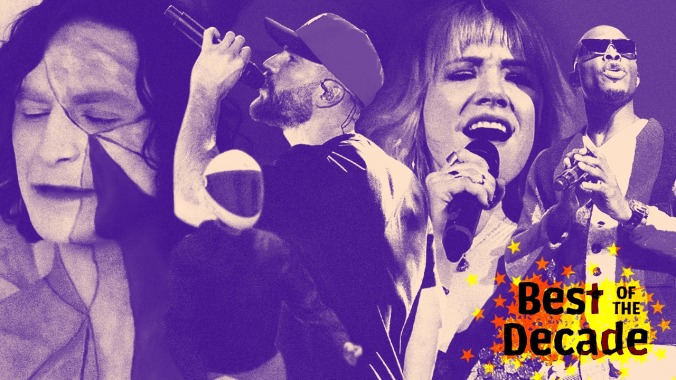The 2010s were the decade of the single
Image: Graphic: Natalie Peeples
On February 24, 2010, Louie Sulcer logged into the iTunes store and bought an MP3 of Johnny Cash’s “Guess Things Happen That Way.” The 71-year-old Woodstock, Georgia, resident later told Rolling Stone that he hadn’t heard the 1958 recording before, but thought it would fit well on a Cash mix he was curating for his son. Unwittingly, however, the download represented the 10 billionth song sold on iTunes, which made Sulcer a mild celebrity. According to the Atlanta Journal-Constitution, Rosanne Cash even called to thank him for listening to her dad’s music, and put her husband, John Leventhal, on the line to strum “Guess Things Happen That Way.”
At the time, Sulcer fit the profile of a typical music consumer. According to statistics tracked by the Recording Industry Association Of America (RIAA), a whopping 1.2 billion download singles were purchased in 2010, which represented 67.1% of total music sales volume and generated $1.3 billion in revenue. By 2018, that share had increased to 75.1% of total sales volume—though the number of download singles actually sold had declined to just 399.8 million units.
Although these numbers illustrate the magnitude of shrinking music sales during the last decade, the data doesn’t mean that singles themselves waned in popularity. If anything, the 2010s were dominated by the single format, in large part because the way people consumed music changed so radically. Rather than buying songs or albums, people streamed them. In 2018, Nielsen Music tracked 901 billion on-demand audio and video streams, an increase of 42.6% over the previous year. This trend shows no signs of abating; in just the first half of 2019, Nielsen tracked 507.7 billion on-demand audio and video streams.
In the 2010s, songs were associated with memes or movements more than albums or artists.
That these measurements are tilted toward tracking individual songs rather than full-lengths isn’t surprising. Streaming-based services such as Apple Music, Spotify, YouTube, and Tidal have a variety of listening options—ranging from free, ad-supported tiers to paid subscriptions—and offer a user experience elevating songs ahead of albums. Part of that is the function of the platforms’ design: Music is arranged chronologically, so in lengthy album rollouts where songs arrive in steady, incremental drips, new individual songs appear first in listings. But Spotify’s desktop app prominently displays an artist’s top 10 songs as measured by streams, while curated playlists—which can encompass highlights of a single artist’s output or be compilations of current hits or genre-specific songs—boil down the essence of an artist’s output to just a few songs.
Songs on these playlists weren’t (and aren’t) necessarily issued as singles, of course, which underscores how the concept of the format evolved in the 2010s. Although individual tracks still drive traditional new-album promotion—labels choose a focus song, service it to radio, and musicians perform the same song during promo appearances—singles more than ever aren’t explicitly tied to full-lengths. In 2017, Sam Hunt spent 34 weeks atop the Hot Country Songs chart with “Body Like A Back Road,” a song he told NashCountryDaily at the start of that year was written while “trying to conceptualize a new record.”
He didn’t mind that “Body Like A Back Road” emerged well before an album:
“As I write these songs, I don’t want to sit on them for as long as it takes me to finish a record before I put them out, so I’m just going to try to put them out as I write them and finish them. As quick as I can get them done, I’ll be shooting them out.”








































